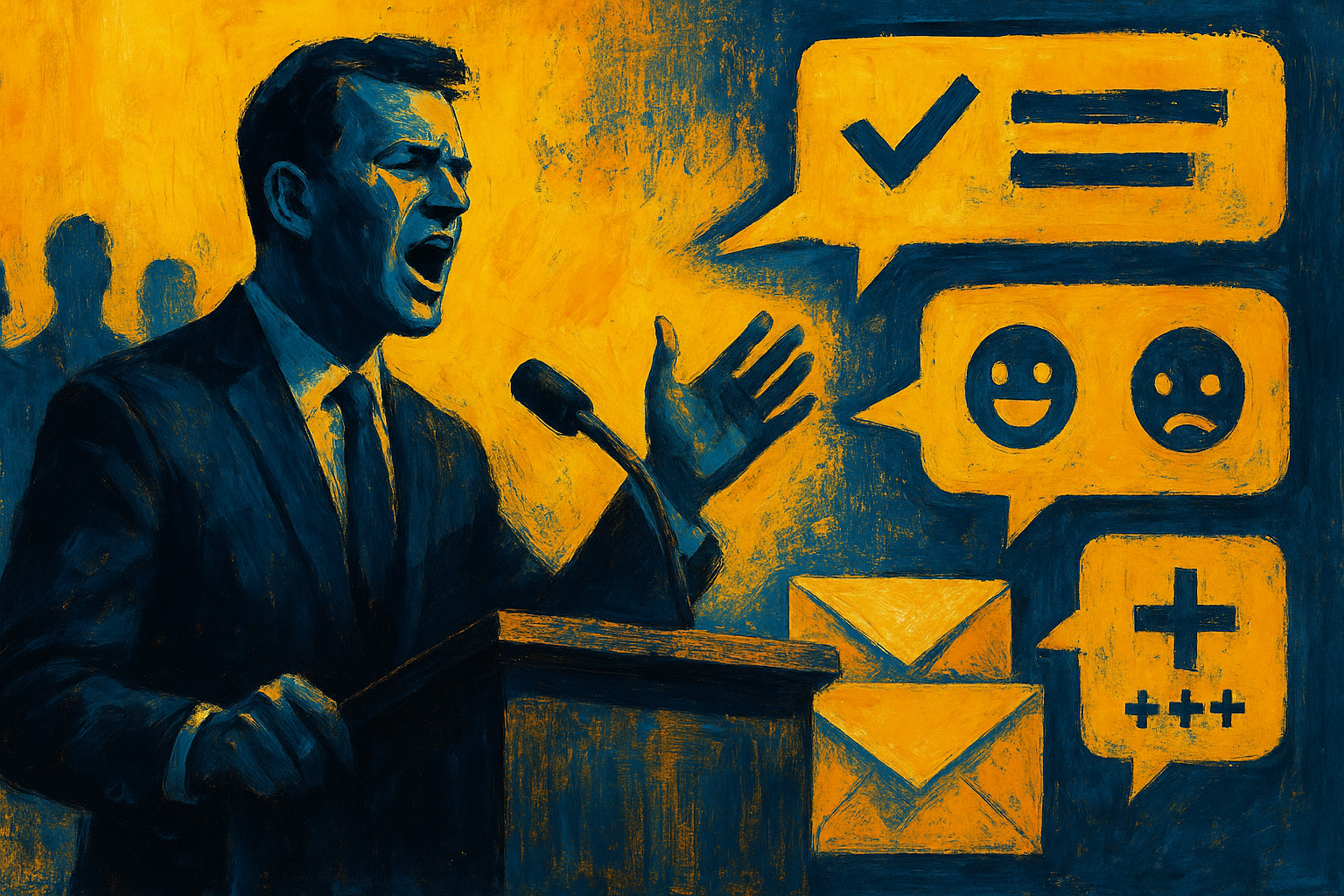Persuasive Political Messaging Strategies That Win Voter Support
Persuasive Political Messaging That Connects & Converts
Winning elections today means cutting through nonstop news alerts, viral memes, and overflowing inboxes to speak directly to voters’ hearts. Persuasive political messaging is the discipline that turns scattered attention into genuine support by blending clear language, authentic tone, and emotional relevance with a laser-focused call to action. This guide shares field-tested strategies that help campaigns, advocacy groups, and first-time candidates craft messages that stick—from granular audience research and story-driven framing to multichannel testing and rapid optimization cycles.
Whether you’re running a city-council race on a shoestring budget or managing statewide media buys, these tactics will sharpen your voice, build trust, and convert undecided citizens into energized believers when turnout matters most at the ballot box this cycle and beyond.

What Is Persuasive Political Messaging?
Persuasive political messaging is the deliberate use of words, images, and stories to shift voter attitudes or actions in a desired direction. It differs from informative messaging, which simply shares facts, and from negative messaging, which aims to discredit opponents. Persuasion goes a step further: it connects a policy or candidacy to a voter’s values and emotions, urging a clear next move such as donating, volunteering, or marking a ballot.
Imagine a mayoral candidate who says, “Our city deserves streets where every child rides to school without fear.” That single line blends clarity (safe streets), emotional pull (children’s safety), and a subtle call to action (support the plan). Awareness alone rarely wins votes; resonance—feeling that the message fits personal hopes or worries—does. That is why campaigns chase persuasion rather than simple attention.
Core Elements of a Persuasive Political Message
A persuasive message must first be clear. Voters glance, decide, and swipe; long sentences or jargon die on contact. Second, it must ring authentic. People spot canned slogans and tune out. Candidates who speak in their own voice—complete with local idioms or personal anecdotes—carry more weight. Third, the content needs relevance, tying directly to what voters discuss at dinner tables today, not last year.
Fourth, emotional appeal turns an abstract promise into a felt experience. Hope, urgency, pride, or even controlled fear can spark action when deployed responsibly. Finally, no message works without a call to action—a line that tells the listener exactly what to do next and why now matters. When these five ingredients line up, persuasion follows almost naturally.
Foundations: Understanding Your Audience for Maximum Impact
Great persuasion starts with knowing who you are talking to. Modern campaigns slice the electorate into segments using demographics such as age and income, psychographics such as personal values, and behavior patterns like past turnout. Surveys, focus groups, social-listening dashboards, and sentiment-analysis tools convert hunches into data. For example, if suburban parents complain about long commutes, a message about job-center transit lanes might resonate more than one about downtown nightlife.
Localizing language deepens the bond: mentioning a specific school mascot or a beloved festival shows real familiarity. Field canvassers relay doorstep comments back to headquarters, allowing digital teams to tweak ads in near-real time. The result is a campaign that speaks personally, not generically, to every corner of its district.
Proven Persuasive Messaging Techniques
One proven technique is storytelling. A voter hearing that “Maria, a nurse from Ward 3, now spends two hours in traffic each night” can visualize the problem better than reading a statistic. Contrast messaging also works: “While the incumbent voted against safer routes, our plan funds them now.” Values-based framing attaches policy to shared ideals such as fairness, freedom, or community pride. Repetition builds recognition; seeing the same core phrase on a yard sign, a Facebook video, and a debate stage cements memory. Finally, vivid language and imagery—clear metaphors, strong color schemes, memorable slogans—give words staying power inside a voter’s mind.
Testing and Optimizing Political Messages
Even brilliant ideas must prove their worth. Modern teams test messages the way software firms test features. They send two versions of a mailer or text—Version A and Version B—to matched voter samples and watch which drives more sign-ups, donations, or engagement. Micro-targeted surveys delivered through online panels or quick phone polls offer early reads, while digital focus groups gather detailed reactions. Dashboards track open rates, click-throughs, sentiment shifts, and qualitative comments. If a headline lifted donations in one neighborhood but fell flat in another, strategists examine context and adjust. Iteration keeps messages fresh, precise, and grounded in real responses rather than wishful thinking.
Multi-Channel Messaging: Reaching Voters Everywhere
Persuasive political messaging gains power when it moves seamlessly across channels. A promise voiced in a debate becomes the headline of a mail piece, the hook in a thirty-second YouTube pre-roll, the caption of an Instagram reel, and the first line of a phone-bank script. Yet tone and length vary: social posts sparkle with brevity, direct mail allows deeper narrative, and text messages favor crisp urgency. Successful campaigns plan a rolling calendar so no medium lags behind, keeping voters immersed in a consistent story wherever they turn. When done right, each touchpoint reinforces the next, turning scattered impressions into a cohesive case for support.
Overcoming Challenges in Persuasive Messaging
Today’s information sphere brims with doubts and distractions. Misinformation can warp a message within minutes; voter fatigue can dull even smart slogans. To overcome these hurdles, campaigns monitor social chatter for false claims, issue swift clarifications, and frame counter-attacks with respect to maintain credibility among persuadables. They refresh creative assets regularly to prevent weariness—changing visuals or rotating endorsements while holding core language steady. Diverse districts pose another test: a single statement might ring true in one community and alienate another. Sub-messages tailored for cultural nuances or local concerns help maintain a broad coalition without losing coherence.
The Responsible Use of Persuasive Messaging
Powerful messaging walks a fine line. Honest persuasion earns trust; manipulative spin risks backlash and legal trouble. Election law bars false claims about voting procedures, and many platforms require disclaimers on sponsored content. Ethical campaigns verify statistics, cite sources, and avoid stoking fear beyond reason. Transparency—such as listing where donations come from or how an ad was paid for—builds long-term credibility that outlives any single cycle. In an era of declining institutional trust, upholding fact-based persuasion is both a moral and strategic imperative.
Conclusion
Persuasive political messaging is not about clever slogans or flashy graphics; it is about meeting voters where they are, speaking their language, and showing—rather than merely telling—how your vision improves their daily lives. When you pair clear, authentic words with data-driven audience insights and continual testing, your campaign transforms from just another voice in the crowd to the voice that resonates, mobilizes, and wins. By grounding every statement in real values, reinforcing it across channels, and adjusting swiftly to feedback, you build lasting credibility and inspire confident action at the ballot box.
Ready to sharpen your campaign’s message and move voters from interest to enthusiastic support?
Today and let our experts craft data-backed, emotion-driven communications that get results.

Jon Sutton
An expert in management, strategy, and field organizing, Jon has been a frequent commentator in national publications.
Author | Partner





